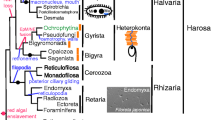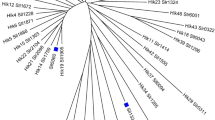Abstract
The majority of Crenarchaeota utilize the cell division system (Cdv) to divide. This system consists of three highly conserved genes, cdvA, cdvB and cdvC that are organized in an operon. CdvC is homologous to the AAA-type ATPase Vps4, involved in multivesicular body biogenesis in eukaryotes. CdvA is a unique archaeal protein that interacts with the membrane, while CdvB is homologous to the eukaryal Vps24 and forms helical filaments. Most Crenarcheota contain additional CdvB paralogs. In Sulfolobus acidocaldarius these are termed CdvB1–3. We have used a gene inactivation approach to determine the impact of these additional cdvB genes on cell division. Independent deletion mutants of these genes were analyzed for growth and protein localization. One of the deletion strains (ΔcdvB3) showed a severe growth defect on plates and delayed growth on liquid medium. It showed the formation of enlarged cells and a defect in DNA segregation. Since these defects are accompanied with an aberrant localization of CdvA and CdvB, we conclude that CdvB3 fulfills an important accessory role in cell division.








Similar content being viewed by others
References
Babst M, Wendland B, Estepa EJ, Emr SD (1998) The Vps4p AAA ATPase regulates membrane association of a vps protein complex required for normal endosome function. EMBO J 17:2982–2993
Brock TD, Brock KM, Belly RT, Weiss RL (1972) Sulfolobus: a new genus of sulfur-oxidizing bacteria living at low pH and high temperature. Archiv Fur Mikrobiologie 84:54–68
Carlton J (2010) The ESCRT machinery: a cellular apparatus for sorting and scission. Biochem Soc Trans 38:1397–1412
Carlton JG, Martin-Serrano J (2007) Parallels between cytokinesis and retroviral budding: a role for the ESCRT machinery. Science 316:1908–1912
Dobro MJ et al (2013) Electron cryotomography of ESCRT assemblies and dividing Sulfolobus cells suggests that spiraling filaments are involved in membrane scission. Mol Biol Cell 24:2319–2327
Ellen AF et al (2009) Proteomic analysis of secreted membrane vesicles of archaeal Sulfolobus species reveals the presence of endosome sorting complex components. Extremophiles 13:67–79
Ellen AF, Albers SV, Driessen AJ (2010) Comparative study of the extracellular proteome of Sulfolobus species reveals limited secretion. Extremophiles 14:87–98
Ellen AF, Rohulya OV, Fusetti F, Wagner M, Albers SV, Driessen AJ (2011) The sulfolobicin genes of Sulfolobus acidocaldarius encode novel antimicrobial proteins. J Bacteriol 193:4380–4387
Ettema TJ, Bernander R (2009) Cell division and the ESCRT complex: a surprise from the archaea. Commun Integr Biol 2:86–88
Ettema TJ, Lindas AC, Bernander R (2011) An actin-based cytoskeleton in archaea. Mol Microbiol 80:1052–1061
Gotz D, Paytubi S, Munro S, Lundgren M, Bernander R, White MF (2007) Responses of hyperthermophilic crenarchaea to UV irradiation. Genome Biol 8:R220
Henne WM, Buchkovich NJ, Emr SD (2011) The ESCRT pathway. Dev Cell 21:77–91
Hobel CF, Albers SV, Driessen AJ, Lupas AN (2008) The Sulfolobus solfataricus AAA protein Sso0909, a homologue of the eukaryotic ESCRT Vps4 ATPase. Biochem Soc Trans 36:94–98
Hurley JH (2008) ESCRT complexes and the biogenesis of multivesicular bodies. Curr Opin Cell Biol 20:4–11
Hurley JH, Hanson PI (2010) Membrane budding and scission by the ESCRT machinery: it’s all in the neck. Nat Rev Mol Cell Biol 11:556–566
Kieffer C et al (2008) Two distinct modes of ESCRT-III recognition are required for VPS4 functions in lysosomal protein targeting and HIV-1 budding. Dev Cell 15:62–73
Li Z, Blissard GW (2012) Cellular VPS4 is required for efficient entry and egress of budded virions of Autographa californica multiple nucleopolyhedrovirus. J Virol 86:459–472
Lindas AC, Bernander R (2013) The cell cycle of archaea. Nat Rev Microbiol 11:627–638
Lindas AC, Karlsson EA, Lindgren MT, Ettema TJ, Bernander R (2008) A unique cell division machinery in the archaea. Proc Natl Acad Sci USA 105:18942–18946
Lowe J, Amos LA (1998) Crystal structure of the bacterial cell-division protein FtsZ. Nature 391:203–206
Maaty WS et al (2006) Characterization of the archaeal thermophile Sulfolobus turreted icosahedral virus validates an evolutionary link among double-stranded DNA viruses from all domains of life. J Virol 80:7625–7635
Makarova KS, Koonin EV (2010) Two new families of the FtsZ-tubulin protein superfamily implicated in membrane remodeling in diverse bacteria and archaea. Biol Direct 5:33
Makarova KS, Yutin N, Bell SD, Koonin EV (2010) Evolution of diverse cell division and vesicle formation systems in archaea. Nat Rev Microbiol 8:731–741
Moriscot C et al (2011) Crenarchaeal CdvA forms double-helical filaments containing DNA and interacts with ESCRT-III-like CdvB. PLoS One 6:e21921
Morita E, Sundquist WI (2004) Retrovirus budding. Annu Rev Cell Dev Biol 20:395–425
Morita E et al (2007) Human ESCRT and ALIX proteins interact with proteins of the midbody and function in cytokinesis. EMBO J 26:4215–4227
Morita E, Colf LA, Karren MA, Sandrin V, Rodesch CK, Sundquist WI (2010) Human ESCRT-III and VPS4 proteins are required for centrosome and spindle maintenance. Proc Natl Acad Sci USA 107:12889–12894
Nunoura T et al (2011) Insights into the evolution of archaea and eukaryotic protein modifier systems revealed by the genome of a novel archaeal group. Nucleic Acids Res 39:3204–3223
Obita T et al (2007) Structural basis for selective recognition of ESCRT-III by the AAA ATPase Vps4. Nature 449:735–739
Ortmann AC et al (2008) Transcriptome analysis of infection of the archaeon Sulfolobus solfataricus with Sulfolobus turreted icosahedral virus. J Virol 82:4874–4883
Peel S, Macheboeuf P, Martinelli N, Weissenhorn W (2011) Divergent pathways lead to ESCRT-III-catalyzed membrane fission. Trends Biochem Sci 36:199–210
Poplawski A, Gullbrand B, Bernander R (2000) The ftsZ gene of Haloferax mediterranei: sequence, conserved gene order, and visualization of the FtsZ ring. Gene 242:357–367
Raiborg C, Stenmark H (2009) The ESCRT machinery in endosomal sorting of ubiquitylated membrane proteins. Nature 458:445–452
Reilly MS, Grogan DW (2001) Characterization of intragenic recombination in a hyperthermophilic archaeon via conjugational DNA exchange. J Bacteriol 183:2943–2946
Saksena S, Sun J, Chu T, Emr SD (2007) ESCRTing proteins in the endocytic pathway. Trends Biochem Sci 32:561–573
Samson RY, Obita T, Freund SM, Williams RL, Bell SD (2008) A role for the ESCRT system in cell division in archaea. Science 322:1710–1713
Samson RY et al (2011) Molecular and structural basis of ESCRT-III recruitment to membranes during archaeal cell division. Mol Cell 41:186–196
Snyder JC, Samson RY, Brumfield SK, Bell SD, Young MJ (2013) Functional interplay between a virus and the ESCRT machinery in Archaea. PNAS 110:10783–10787
Stuchell-Brereton MD, Skalicky JJ, Kieffer C, Karren MA, Ghaffarian S, Sundquist WI (2007) ESCRT-III recognition by VPS4 ATPases. Nature 449:740–744
Wagner M, Berkner S, Ajon M, Driessen AJ, Lipps G, Albers SV (2009) Expanding and understanding the genetic toolbox of the hyperthermophilic genus Sulfolobus. Biochem Soc Trans 37:97–101
Wang X, Lutkenhaus J (1996) FtsZ ring: the eubacterial division apparatus conserved in archaebacteria. Mol Microbiol 21:313–319
Williams RL, Urbe S (2007) The emerging shape of the ESCRT machinery. Nat Rev Mol Cell Biol 8:355–368
Wollert T, Yang D, Ren X, Lee HH, Im YJ, Hurley JH (2009) The ESCRT machinery at a glance. J Cell Sci 122:2163–2166
Acknowledgments
Thanks to Dirk-Jan Scheffers for help with the fluorescence microscopy, and Maarten Mols for assistance in the flow cytometry. We are grateful to Ralf Bernander (Stockholm University, Sweden) for kindly providing the Cdv antibodies.
Author information
Authors and Affiliations
Corresponding author
Additional information
Communicated by L. Huang.
Electronic supplementary material
Below is the link to the electronic supplementary material.
Rights and permissions
About this article
Cite this article
Yang, N., Driessen, A.J.M. Deletion of cdvB paralogous genes of Sulfolobus acidocaldarius impairs cell division. Extremophiles 18, 331–339 (2014). https://doi.org/10.1007/s00792-013-0618-5
Received:
Accepted:
Published:
Issue Date:
DOI: https://doi.org/10.1007/s00792-013-0618-5




